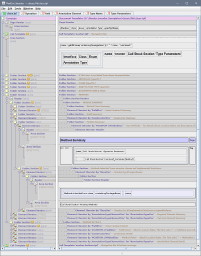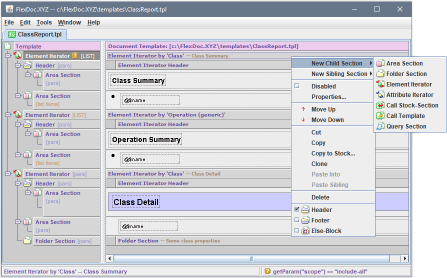FlexDoc.XYZ - Overview
- Introduction
- What are Templates?
- Data Sources
- How Data Processed
- Output Generation
- Core Components
- Applications
1. Introduction
FlexDoc.XYZ is a technology for rapid development of template-based documentation/report generators built into Java applications.It is based on an idea that most of the data, which a typical application operates, have a tree or network structure and generally can be represented in a form similar to Document Object Model (DOM) of XML files. (In fact, that's why XML is widely used to export/import those data and exchange between applications.)
Following that idea, it is possible to imagine that if we had some abstract interface that can represent most of practically used data sources in some universal form similar to DOM, we could process such data using a single tool, which is based only on the concepts of XML (possibly with a few enhancements) and employs some standards and approaches developed around it.
FlexDoc.XYZ was devised as an implementation of that idea for the task of representing the application data in some human-readable form, i.e. generating various reports and documentation.
Another idea related to that task and sought to achieve in FlexDoc.XYZ is a universal approach for specifying formatting of the output documents and generating a common network of hyperlinks interconnecting them.
The natural way to achieve all those goals would be to introduce a new programming medium in the form of a scripting language or template language.
Scripts versus Templates
A scripting language is typically something intended for manual coding, compiling and running with an interpreter. Normally, this approach provides powerful expressive capabilities, however in expense of a rather cumbersome (and laborious) way of using them. For instance:- Most of program semantics comes down to lots of identifiers (e.g. the names of functions, variables, parameters, labels etc.) and relations between them. You need to properly declare/define all of them and track across one or many scripts, keeping in mind both their meaning and how they are connected to each other.
- The processing instructions (or structures) associated with those identifiers must follow some complex syntax, which may be cumbersome to write down, however easy to spoil, thereby introducing a bug.
- The highly expressive capabilities of some operators and language constructs mean that you can widely change their semantics with just a few settings or properties. That, however, is also an easy way for bugs.
- Scripts are plain texts. Typically, without a special documentation, it is hard to understand what they actually do. This makes difficult further modifications, particularly by non-authors of those scripts.
- A scripting language is hard to extend with new features and functionality because you need to maintain the backward compatibility and consistency of huge a lot of things.
As templates we call some structures intended for editing only with some software: a graphic Template Designer. It is also a sort of language, however expressed in the form of visual controls and components displayed in the designer GUI. Now, instead of keywords and operators, you work with some interactive things that show up on the screen and represent most of the processing semantics. Like scripts, templates are programs, which must be stored in some files and interpreted by a Template Processor. This approach has the following advantages:
- The processing structures represented by template components may be displayed in a way that visually expresses what a component does (for instance, it may resemble the output it generates). That representation may be both expressive and compact (after all, it is not just a text), which allows you easily to navigate a template, understand what it does and modify anything you need.
- As template components are visual and interactive, they may have very complex internal structure, for instance, contain lots of properties and nested components. At that, you don't need to scroll and navigate some kind of enormous text, which encodes all of this (as it would be in case of a script). Rather, you just need to invoke some property dialogs and expand/collapse some component sections.
- A template component may be easily copied, pasted and deleted as a whole. At that, you don't need to bother that the template syntax is restored after that. The template designer will also ensure that each component is created, copied or moved only in the allowed place.
- The highly structured nature of templates eliminates the need for most of various named identifiers. Many connections between different template components will be also maintained by the Template Designer (i.e. modified automatically when necessary).
- As template files are stored and read only programmatically, there is no need to know and understand their syntax. There will be no syntax errors either.
- The actual template syntax may be optimized not for human programmers, but for faster loading and processing of templates by the Template Processor. There is no need in a compilation phase.
- The separation of template semantics from the particular structure of template files helps for faster and easier evolution of the template language. The obsolete constructs of older template versions can be automatically converted into new structures. Both old and new templates will look and work up-to-date.
2. What are Templates?
FlexDoc.XYZ templates are programs. The idea behind the templates is the following.If you consider how almost any Java library that generates something (and not only generates – for instance, powers a GUI system) works, you will notice that, basically, it may be described as follows:
- First, we need to create a certain object representation of some controlling structure (using special classes and methods of that library).
-
Further, we call an interpreter included in that library and pass to it that controlling structure
along with some data source we want to process, e.g. some data file, some interface or whatsoever.
Actually, such an interpreter may be started just by calling some member method of the root object representing that controlling structure. For instance, in case of a GUI system, this may be as simple as
dlg.show(). - Finally, the interpreter processes that controlling structure and produces from the data source some useful output (or shows a GUI).
But when that is a template, why not to create and edit it using some template designer GUI? That approach has a number of advantages:
- A designer GUI can visualize everything. Now, rather than coding abstract method calls, we can visually construct the controlling structure using the notions of things we expect to see in the generated output.
- Since probably every modern document format in its core is based on the same obvious concepts like flows of text with specified fonts and colors, paragraphs with specified margins, borders and other properties, tables, bulleted/numbered lists, images and so on, most of such things can be defined in some universal format-independent way, which can be encoded in the form of template components.
- Such template components can be visualized in the template designer GUI. This allows easy manipulation with them (creating/defining, modifying, moving, coping and so on). Doing the same by calling various Java methods and modifying Java code each time we need to change something would be a lot more cumbersome!
- On other hand, the template interpreter will render those template components with the suitable features of the particular destination output format (such as HTML or RTF). So, we can be relieved from learning and programming lots of very complicated (and sometimes poorly documented) things specific to a particular format. Instead, we can concentrate more on our primary application task.
- The template designer ensures (to a large degree) that the result controlling structure (the template) is valid. That is, it won't hang when interpreted and will produce some output anyway.
The following screenshot shows a template open in the template designer (click to enlarge):
Template Sets
A template typically generates a single output document or a fragment of it.The large documentation generator is implemented as a set of template (also called template application). It includes one or several main templates, which are those specified to the template processor. All others are subsidiary templates (or subtemplates) that work as procedures. They are called from the main templates as well as each other.
Different main templates may implement different variations of the same documentation generator, for instance, to generate multi-file frameset HTML or single-file HTML/RTF documentation etc.
Examples
The following are three such template applications implementing professional-grade documentation generators. The screenshots show demo documentation generated with each template set (click to see HTML).
|
FlexDoc/XML XSDDoc
A template set for FlexDoc/XML 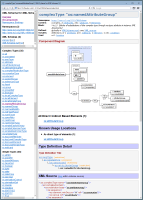
|
FlexDoc/XML WSDLDoc
A template set for FlexDoc/XML 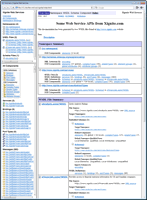
|
JavadocClassic
A template set for FlexDoc/Javadoc 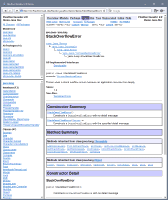
|
About Template Format
FlexDoc.XYZ templates are plain text files, which look similar to XML. This is not XML, however.Currently, the FlexDoc.XYZ template language is still evolving. We constantly add new features and change some constructions. But we always make sure to support any legacy settings and functionality. Each template starts with the line like this:
-
<FLEXDOCXYZ_TEMPLATE VER='1.22'>
The version number allows the template processor to recognize what a template that is and how it must be treated. The template parser includes pieces of code that convert any legacy constructions into the new ones.
Although the content of a template file looks somewhat similar to XML and even can be converted to XML entirely, currently, we do not plan to do this because:
- The template proprietary format makes it much easier to introduce new features and change the old ones (especially with the respect to the necessary support of any legacy constructions).
- Currently, we have ultra-fast template parser, which parses each template directly into a separate instance of the output generator. In effect, the template is treated as if it is a serialized sub-generator itself. Switching to XML as the base template format will immediately add an extra layer of processing and slow it down.
- Since the introduction of Commercial Template Applications (which embody substantial intellectual property), now licenses must be attached directly to the templates (rather than some binary executable code). Having the proprietary format helps with this.
3. Data Sources
FlexDoc.XYZ core connects to one or several data sources provided by a Java application using a special driver written with the FlexDoc.XYZ API.Any such a driver represents particular data source in a form structurally similar to DOM and understandable to FlexDoc.XYZ core. Such a representation is called Data Source Model (or DSM) and any driver supporting it – DSM Driver. The job of that driver is to provide any external data through an universal DSM Interface, which it must implement.
Any DSM may be considered as a virtual XML document. It contains elements (called DSM elements) and attributes (called DSM attributes). However, unlike elements/attributes in an XML file, DSM elements and attributes are not real things. Rather, they are instances of special interfaces implemented by the DSM Driver. That makes them capable to provide dynamically a lot more information from the underlying data source (rather than an ordinary XML document).
All possible data sources processed by the same DSM Driver are described by a certain DSM Type (which may be considered as an equivalent of XML schema or DTD). The DSM driver provides the data structure and type information associated with this DSM Type via the special DSM Type Interface (which is used by bother the Template Designer and Template Processor).
Actually, some DSM Driver implementations may process different DSM Types. For instance, FlexDoc/XML includes the «XML Model Driver», which works with the data from XML files. That driver can be initialized from different XML schemas (or DTDs) passed as initialization parameters so as to represent each time a different DSM Type associated with particular type of XML files (XML vocabulary).
In fact, all existing FlexDoc.XYZ applications represent little more than the same core plus one or more specific DSM drivers.4. How Data Processed
Data processing scheme implemented in FlexDoc.XYZ in many ways is similar to that used in XSLT. In brief, it can be described as follows.FlexDoc.XYZ templates are built of nested components called sections. Most important of them are Element Iterators and Area Sections. An Element Iterator performs iterations by a set of elements which it produces from the context element received from the iterator's parent. The set of iterated elements is generated according to the Location Rules, which are settings based on a subset of XPath (however, with some important extensions that allow traversing element references). During the iterations, each iterated element is selected as a context element and the iterator's content is repeated for it. Area Sections do not perform iterations. Instead, they are programmed to generate some output from the context element. The template interpretation starts from the template's root section block. The root element of the processed XML document becomes the first context element.
It can be seen, that Element Iterators
produce the same effect as <xsl:template> / <xsl:apply-templates>
directives and FlexDoc.XYZ templates themselves are analogues of XSLT-scripts.
However, it should be noted that FlexDoc.XYZ is not based on XSLT and does not use any XSLT processor internally.
For further information, see Data Processing and Templates/Template Designer features, where you can find many details about FlexDoc.XYZ templates and data processing capabilities.
See also FlexDoc/XML | Samples | Alternative to XSLT, which demonstrate how FlexDoc.XYZ can be used as an alternative to XSLT.
5. Output Generation
There are two types of output that can be generated by FlexDoc.XYZ:- Single file documents
- Framed multi-file HTML documentation
Each interpretation of a document template normally results in generation of a single output document. Document templates also are the places where all the output formatting specified.
The FlexDoc.XYZ architecture was devised so that to allow designing document templates independently on a particular destination format. The specific format is selected just at the moment of starting the generation. All instructions and settings specified in a document template will be rendered with appropriate features of the selected output format. For more information about formatting techniques supported in FlexDoc, see Formatting Features.
Frameset templates are entirely based on calls of subtemplates. This time, each subtemplate call generates a separate subordinate document. A frameset template itself generates a special frameset document which contains no actual data, but instead, specifies the frame windows where subordinate documents are displayed.
6. Core Components
Any FlexDoc.XYZ application consists basically of three main components:DSM Driver
The job of the DSM Driver is to connect to the external data source (that is some Java API) and represent all its data in the form of a DSM (Data Source Model), which is a DOM-like structure understandable to the template processor. DSM driver also provides the general data type information about all possible data sources it can represent. That information comes in an abstract form called DSM Type, which is used by both the template designer and template processor.The DSM Driver may be a very complex thing, which must be implemented specifically for each particular FlexDoc.XYZ application.
See also: Data Sources
Template Designer
Provides a GUI to design templates. Essentially, it creates a visualization of the template language. It is a constant component, which is the same in all FlexDoc.XYZ applications. However, the template designer requires the data type information about possible data sources processed by the templates. That information is provided by the DSM Driver via the DSM Type Interface.Template Processor (Generator)
It is another constant component of any FlexDoc.XYZ application and the most complex one. Basically, it makes everything work.The template processor consists of two logical parts:
- Template Interpreter
- Output Generator
- A data source, which depending on the application field may be, for instance, some XML files or the Javadoc started to process a particular Java project. The data source is passed to the DSM Driver as its argument.
- A template (or the main template of a template application).
Actually, the template intrepreter and output generator is a single thing. It consists of some large abstract implementation with several extensions for particular output formats (HTML, RTF, TXT).
The template processor can be run directly from the Java command line (or automatically from some Java program, when it is wrapped in some kind of plugin; see FlexDoc/Javadoc). In that case, all interpreter/generator settings must be specified as command line options.
Alternatively, the template processor can be run from a special generator GUI, which allows the user to specify all settings interactively.
Below, you can see a screenshot of the generator GUI of FlexDoc/XML:

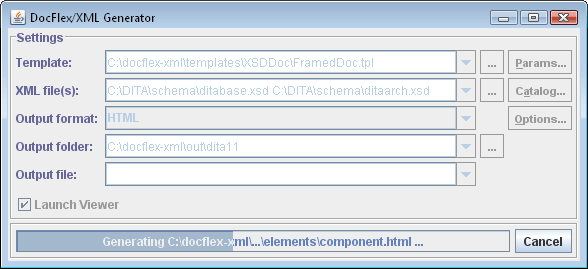
7. Applications
Under the term “FlexDoc.XYZ application”, we mean an implementation of some specific template-driven documentation generator in a certain programming field, which is defined by where the input data come from. Typically, this is also accompanied by the development of some complex template applications, which solve practical tasks (like the generation of Java API documentation, XML schema documentation etc.)So far, we have developed three such implementations:
| Application | Description |
|---|---|
| FlexDoc/XML | The documentation generator by the data obtained from XML files. This is currently the most complex and advanced FlexDoc.XYZ application. |
| FlexDoc/Javadoc | The template-driven Java API documentation generator. It is wrapped in the form of a Javadoc Doclet and takes its data from the Doclet API. |
| FlexDoc/Together | This was the first practical application of FlexDoc.XYZ – a template-driven UML documentation generator implemented as a plugin for Borland Together (a UML modelling tool). |

